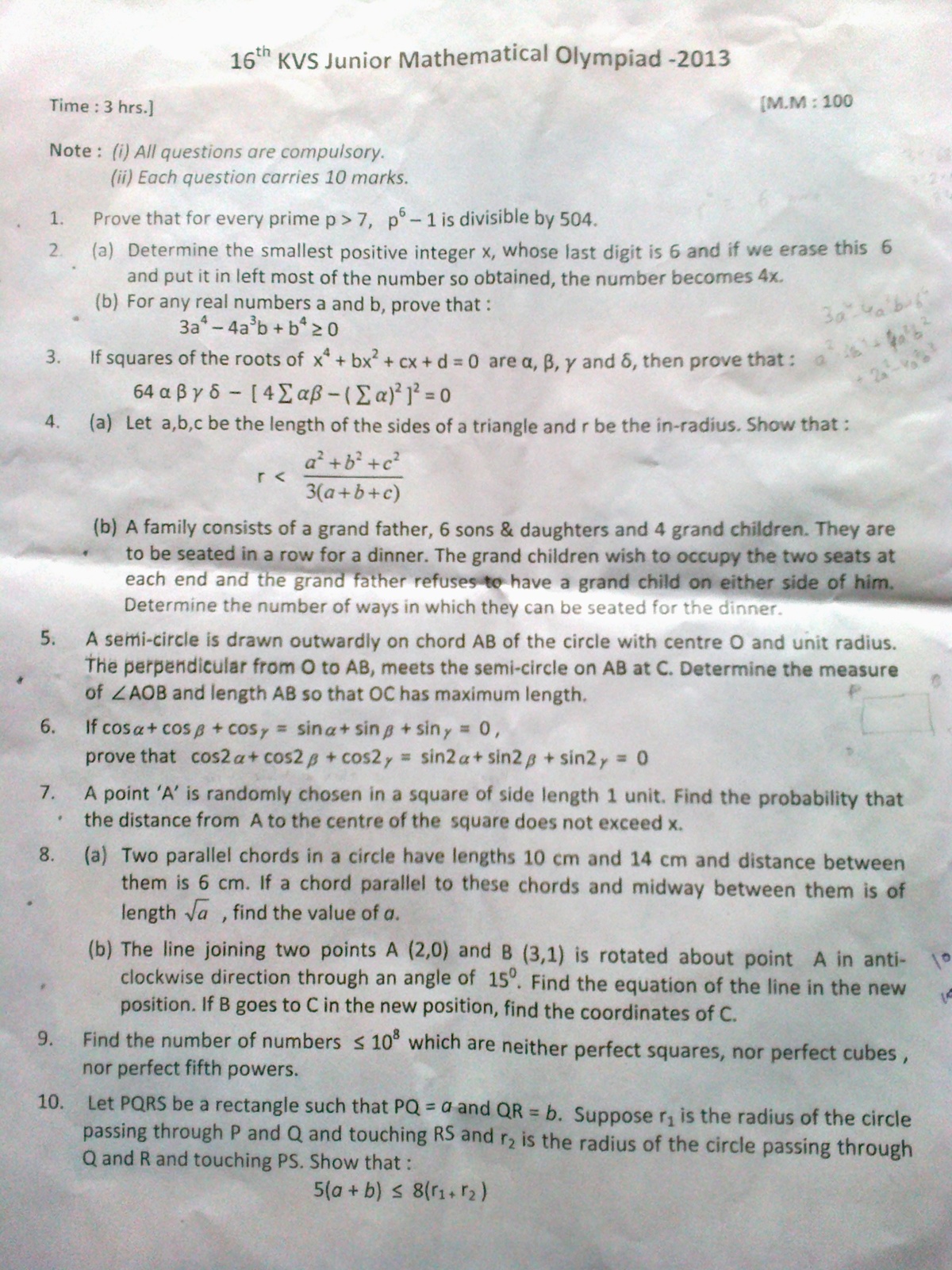Junior Mathematics Olympiad questions

Hello all, This is the question paper of JMO. Please help me with the solutions. Post solutions in the comment providing question number. Thanks.
No vote yet
4 votes
Easy Math Editor
This discussion board is a place to discuss our Daily Challenges and the math and science related to those challenges. Explanations are more than just a solution — they should explain the steps and thinking strategies that you used to obtain the solution. Comments should further the discussion of math and science.
When posting on Brilliant:
*italics*or_italics_**bold**or__bold__paragraph 1
paragraph 2
[example link](https://brilliant.org)> This is a quote# I indented these lines # 4 spaces, and now they show # up as a code block. print "hello world"\(...\)or\[...\]to ensure proper formatting.2 \times 32^{34}a_{i-1}\frac{2}{3}\sqrt{2}\sum_{i=1}^3\sin \theta\boxed{123}Comments
[6] Let cosα+i⋅sinα=eiα
cosβ+i⋅sinβ=eiβ
cosγ+i⋅sinγ=eiγ
Now Given cosα+cosβ+cosγ=0.........................(1)
and sinα+sinβ+sinγ=0.......................................(2)×i
Add These two equations::
eiα+eiβ+eiγ=0...................................................(3)
Now Square both Side
e2iα+e2iβ+e2iγ+2(ei(α+β)+ei(β+γ)+ei(γ+α))=0
Now in a △ Sum of angle i.e α+β+γ=π⇔α+β=π−γ
So e2iα+e2iβ+e2iγ+ei(π−γ)+ei(π−β)+ei(π−α)=0
e2iα+e2iβ+e2iγ+ei(π−γ)−2(e−iα+e−iβ+e−iγ)=0
Now from (3), Taking Congugate on both side, we get
e−iα+e−iβ+e−iγ=0
So e2iα+e2iβ+e2iγ=0
So cos2α+cos2β+cos2γ+i(sin2α+sin2β+sin2γ)=0+i⋅0
we Get cos2α+cos2β+cos2γ=0
and sin2α+sin2β+sin2γ=0
Question 10.
Firstly r1=8b1(a2+4b2) and r2=8a1(4a2+b2). To see this, for example, suppose that P has coordinates (0,21a), Q coordinates (0,−21a). Then the centre of the first circle will have coordinates (x,0) for some x, and the circle will touch RS at its midpoint (b,0). Then x2+41a2=(b−x)2, which gives us x. Then r1=b−x. While x could be negative, r1 cannot.
Then r1+r2===8aba(a2+4b2)+b(4a2+b2)=8aba3+b3+4a2b+4ab28ab(a+b)(a2−ab+b2+4ab)=8ab(a+b)(a2+3ab+b2)81(a+b)[3+ba+ab]≥81(a+b)[3+2]=85(a+b)
Please help me with your solutions..
Log in to reply
Did you try them already? Which did you manage to solve?
Log in to reply
I did q.1,2,4(b), 5,7,8, but try to give solutions of every question, so that I could verify my answers
Log in to reply
It would be better for you to state your solutions / approaches, and have others comment on it.
There can be subtleties in proof based questions, which would result in a 'similar-looking' answer being marked wrong.
Tell which one you couldn't solve .
Log in to reply
Please give solutions to all the questions you can, I will check the questions done by me and will understand what didn't solved.. Thanks
Here are the anwers ( not for the proof - type questions.)
2(a) →153846
4(b) →7!4!(26)
5 → 90
7 →πx2
8(a) →184
8(b) →x−y3−2=0 , (2+23,21)
Log in to reply
yes, thanks, question 2(a), 5, 7, 8(a) matches with my solution, but can you give some explanation in 4(b). and I think your 8(b) is wrong. the angle of AC with x-axis is 60 degree. So, tan60=x−2y−0 Thus equation is y=3x−23 which is my answer, and the coordinate also has some error. Am I right?
Log in to reply
ok , i went wrong in q.8(b) , it is rotated anti - clockwise , i rotated it clockwise.
4(b) Give end seats to grandchildren in 4×3 ways.
Now choose 1 seat out of 7 for grandfather( you can't select the seat which second from left or right.).in 7 ways.
Then choose 2 seats out of 6 for remaining two grandchildren ( as we can't choose from grandfather's left or right and 3 seats are already occupied) and permutate in (26)2! ways.
Now , six seats for sons and daughters remain , 6! ways for them.
Total no. of ways = 4×3×7×(26)2!×6!=7!4!(26)
Log in to reply
am I right in question 8(b), then what is the coordinate of C? In 4. how did you write- Give end seats to grandchildren in 4×3 ways? as far as I have understood the question,two seats each on the left and right ends of row is occupied by children. Am I wrong or You are mistaken..
Log in to reply
Left and Right end seats are occupied by grand children .
For left seat it has four options and right has three options ( as one is already taken by left one.). Hence by Fundamental principle of counting , no. of ways = 4×3.
8(b) . (2+21,23)
Log in to reply
okay, 8(b) is correct and also matches my solution.
In 4, I am still confused.Look and find error in my solution, it goes like this:
The extreme 2 seats on both ends are occupied by grand children. So 4 grand children occupy 4 seats in 4! ways. Numbering the seats 1,2,3.....11, we find that Grandfather canno sit on 3rd and 9th seat. So grandfather can sit on any one of 4th,5th,6th,7th,8th seats. This is done in 5 ways.
Now after this arrangement, we have 6 seats left on which 6 son/daughter is to sit. This can be done in 6! ways
Therefore total possibilities= 4!.5.6!
I am getting your logic. Please check: https://brilliant.org/discussions/thread/an-olympiad-level-question-of-combinomatrics/
Challenge masters please give some hints!!!!!!!!!!
The first question is very easy to solve. First of all, p^6 - 1 is divisible by 7, can be proved by fermat's little theorem. Next, p^6 -1 can be factorised to find whether it is divisible by 3^2, next the factorisation can also help to find whther it is divisble by 2^3. So 504 = 7* (3^2) * (2^3). This means p^6-1 is divisible by 504.
Question 9 is nothing but inclusion-exclusion principle...perhaps!
Log in to reply
how to do it? if we can find the number of cubes less than 108 and number of fifth power numbers less than 108 then only we can solve it. Is there another way?
Where and when is this exam held?
is the answer of ques 8 34????
Log in to reply
which part, 8(a) or 8(b)
Log in to reply
(A)
Log in to reply
its 184
2[b]:: Here a,b∈R and 3a4−4a3b+b4≥0
Now this is a Homogeneous equation, so Let a=bx and Let y=3b4x4−4b3x3⋅b+b4
So y=b4⋅(3x4−4x3+1)=b4⋅(x−1)2⋅(3x2+2x+1)≥0
bcz 3x2+2x+1=3(x+31)2+38>0∀x∈R
Log in to reply
There is also a simple answer to this. It goes like this:
We have, 3a4−4a3b+b4 =a4−2a2b2+b4+2a2b2+2a4−4a3b =(a2−b2)2+2a2(b2+a2−2ab) =(a2−b2)2+2a2(a−b)2≥0